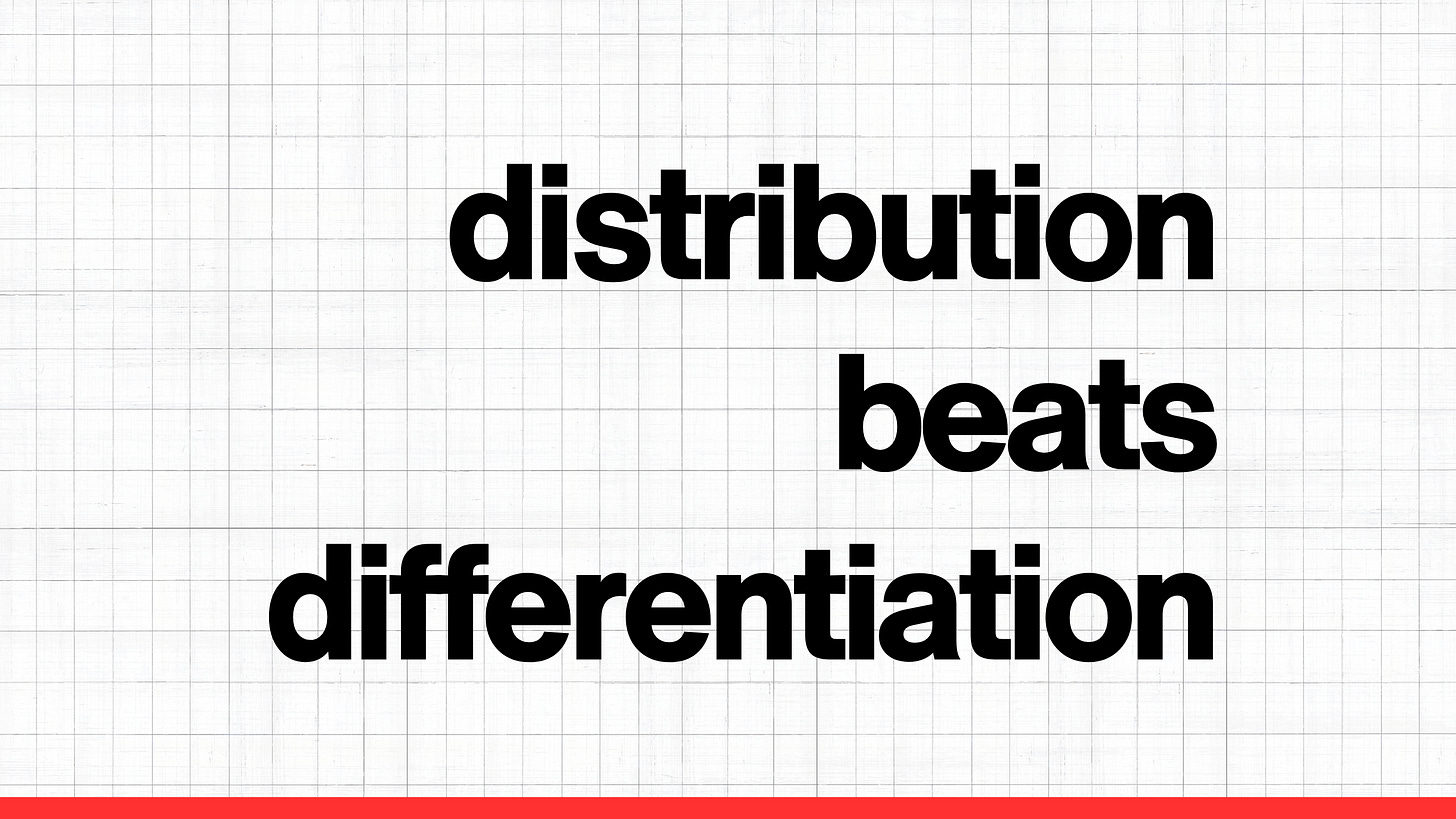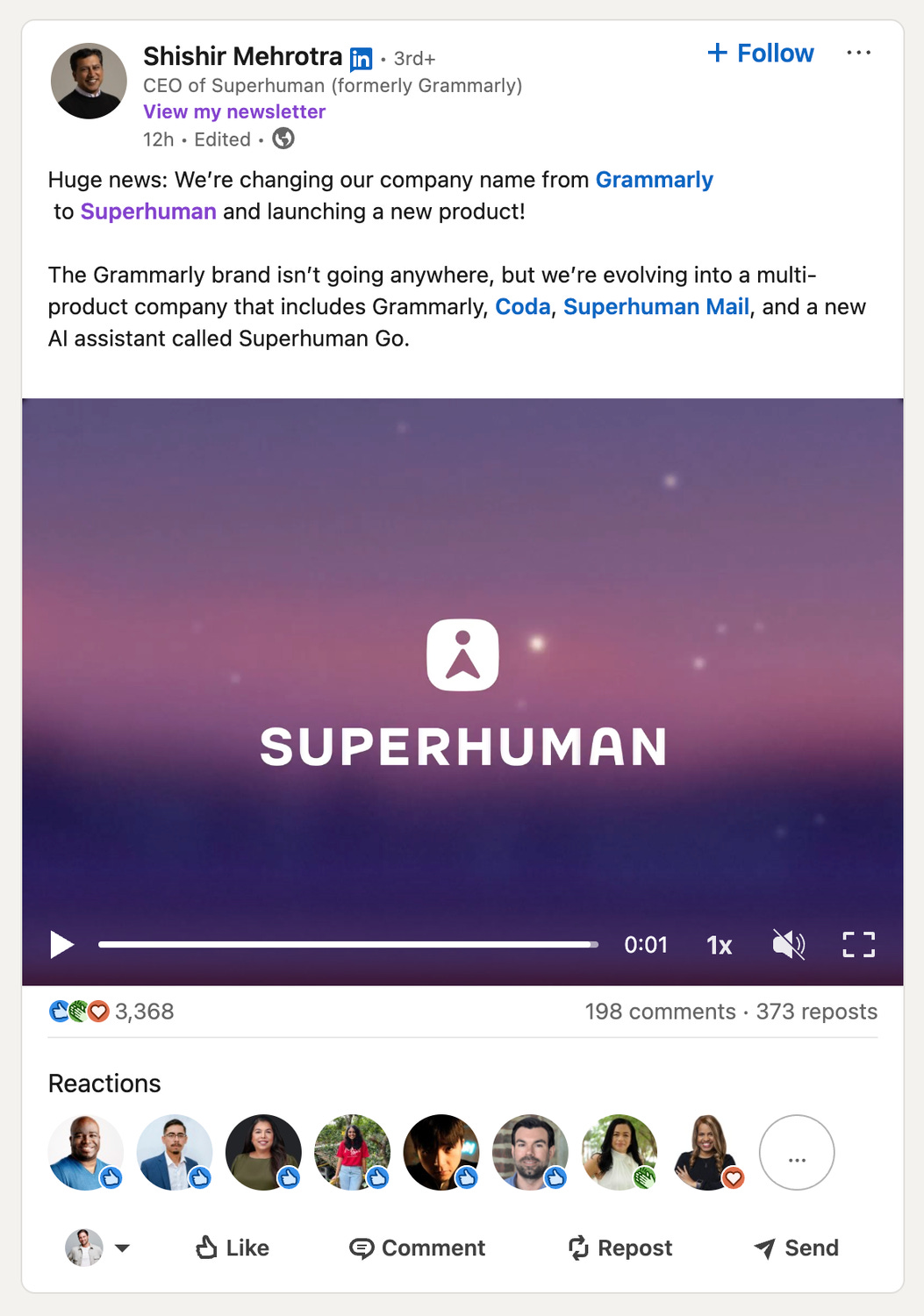Killing Grammarly was the smart move
When you hear Grammarly you think grammar, not intelligence
Shihir Mehrotra (CEO of Superhuman) changed the company name from Grammarly to acquired company Superhuman.
Everyone in the tech press screamed brand suicide.
I think it’s the smartest move they could of made.
One of the most sophisticated distribution plays I have seen.
Let me go full hyperbole mode for a second.
Ready?
Superhuman are repositioning for war.
Here’s why.
The death of the grammar police
Grammarly had a brand problem.
The company built an empire on a single promise... fix your typos.
By 2025 they had assembled one of the most impressive distribution machines in software.
40 million daily active users.
Presence in over 1 million apps and websites.
50,000 enterprise customers.
$700 million in annual recurring revenue with 80% gross margins.
Unfortunately for them, when you hear “Grammarly” you think grammar.
Not strategy.
Not intelligence.
Not the future of work.
To win in the AI wars, specifically the productivity software market, the growth is in platforms.
Bundles.
Operating systems for work.
The big dogs know this.
Microsoft Copilot, despite its messy rollout, now sits inside 70% of Fortune 500 companies.
Google Gemini powers 46% of US enterprises in productivity workflows.
OpenAI just launched AgentKit, a complete platform for building, deploying and managing AI agents.
The future belongs to whoever owns the layer where work actually happens.
Grammarly doesn’t own that, so they killed it.
Here comes another agent platform
The companies that control the orchestration layer, aka the place where agents talk to each other and to your data, will capture disproportionate value.
The connective tissue between you and every app you touch.
Your email, docs, CRM, Slack, everything.
Grammarly (Superhuman) is building that AND they’re running multiple AI agents on top of that layer.
One agent fixes your grammar.
Another researches prospects.
A third schedules meetings.
A fourth drafts responses in your voice.
All orchestrated by an agent platform called Superhuman Go.
So what did Superhuman bundle?
Grammarly’s writing tools, Coda’s workspace platform, Superhuman Mail and the new agent overlay with an Agent Store and SDK.
An operating system for AI-augmented work.
A classic “rundle” strategy (recurring revenue bundle).
Microsoft did it with Office 365 and Adobe did it with Creative Cloud.
Bundle complementary products at a unified price point, make the integration seamless and make switching costly and difficult.
A customer using one Superhuman product might churn.
A customer using four, with agents running across all of them, trained on their writing style, plugged into their workflows is well and truly locked in.
Distribution beats demo, always
Grammarly already won the distribution war.
They sit inside 1 million apps and websites.
They have 40 million people using them every single day.
To understand why this matters, you need to understand what knowledge workers actually do all day:
The average employee spends 28% of their workweek on email.
11 hours a week just managing the inbox.
They receive 117 emails and 153 Teams messages every single day.
People get interrupted every two minutes during core work hours.
275 interruptions per day.
Microsoft calls this the “infinite workday”.
This is the problem Superhuman Go attacks.
Context-switching.
The cognitive tax of navigating fifteen different tools to complete one task.
They’re attacking it from inside the tools you already use. That’s the distribution moat.
When OpenAI launches AgentKit, they need you to come to ChatGPT.
When Microsoft rolls out Copilot, they need you to open a sidebar.
When Google pushes Gemini Enterprise, they need you to adopt another interface.
Superhuman says... “We’re already where you type. Just turn us on.”
That’s a $1 billion head start.
The platform playbook
Now let’s talk about how their platform scales.
They’re shipping an Agent Store and an Agents SDK. That means third parties can build agents that run on Superhuman’s rails.
Quizlet for education.
Fireflies for meeting notes.
Speechify for audio.
Each new agent increases their surface area. Each integration raises switching costs.
This is the flywheel that made iOS and Android unstoppable.
Apple didn’t build every app. They created the marketplace and the tools, then let developers fill in the gaps. By the time Android arrived, Apple already had hundreds of thousands of apps.
Switching meant losing your entire digital life.
Superhuman is betting the same physics apply to work agents.
Can they pull it off?
Microsoft Copilot has distribution through Office 365’s 400 million users but adoption is a mess.
Gartner’s 2025 survey found that while 94% of enterprises report benefits from Copilot, only 6% have completed global rollouts.
Google Gemini has momentum, 82 million monthly active users, 46% penetration in US enterprises but it’s fighting the exact platform dependency problem Superhuman is exploiting.
OpenAI’s AgentKit is the real threat. It launched in October 2025 with the weight of ChatGPT’s 60.5% market share in generative AI chatbots. They have developer mindshare, a visual Agent Builder and enterprise wins like Klarna (handling a majority of support tickets) and HubSpot (powering Breeze for sales automation).
OpenAI doesn’t have Superhuman’s distribution rails.
ChatGPT requires you to come to ChatGPT. Superhuman is already inside your browser, your docs and your email client.
They’re there already.
In the battle for the operating layer of work, being there already wins.
The bet
My take. This move works.
Not because the rebrand is flawless, it’s not. Not because “Superhuman” is a better name, that’s a matter of personal taste.
It works because Grammarly understood the fundamental law of enterprise software in the AI era.
Distribution beats differentiation.
You can build the smartest agent. The best model. The sleekest interface.
If you don’t control the surface where work happens, where people type, where they read, where they decide, you’re renting attention from someone else.
They’re doing it at exactly the moment when the market is deciding who gets to be the operating system for AI-augmented work.
Microsoft and Google are the incumbents, defending installed bases.
OpenAI is the insurgent, leveraging ChatGPT’s consumer momentum.
Superhuman is the dark horse, already embedded in your workflow, asking you to just turn on the full suite.
In five years, one of three things will be true:
Microsoft or Google crushed everyone by bundling AI so deeply into Office/Workspace that third-party overlays became irrelevant.
OpenAI became the “AI OS” by making ChatGPT the default interface for every digital task.
Superhuman became the independent, cross-platform orchestration layer because they own presence at the point of creation.
Whatever happens, we’ll soon find out what the most powerful distribution moat actually is.
Until next time.
Blake




